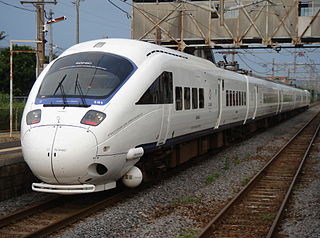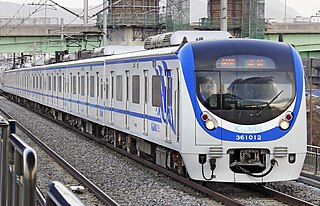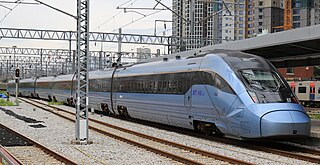
The Korea Railroad Corporation, branded as KORAIL, is the national railway operator in South Korea. Currently, KORAIL is a public corporation, managed by Ministry of Land, Infrastructure and Transportation.

Korea Train eXpress (Korean: 한국고속철도), often known as KTX, is South Korea's high-speed rail system, operated by Korail. Construction began on the high-speed line from Seoul to Busan in 1992. KTX services were launched on April 1, 2004.

Seoul Subway Line 1 of the Seoul Metropolitan Subway is a rapid transit and commuter rail line which links central Seoul, South Korea to Soyosan Station in the northeast, Incheon in the southwest, and Sinchang via Suwon and Cheonan in the south. The central underground portion of Line 1, running underneath Sejongno, Jongno, and Wangsan-ro avenues along Seoul's traditional downtown area, is the oldest subway-operated section in the Seoul Metropolitan Subway system. Its branches and services cover a large part of the Seoul Capital Area; totaling 200.60 km (124.65 mi) in route length.

Hyundai Rotem (Korean: 현대로템) is a South Korean company that manufactures rolling stock, defense products and plant equipment. It is a part of the Hyundai Motor Group. Its name was changed from Rotem to Hyundai Rotem in December 2007 to reflect the parent company. It is also called Hyundai Railroad Technology Systems.

Seoul Subway Line 4 of the Seoul Metropolitan Subway is a long line crossing from the southwest to the northeast across the Seoul National Capital Area. The central section in Seoul City is operated by Seoul Metro with some trains offering through service to Korail's Ansan and Gwacheon Lines. The southern terminus (Oido) is in Jeongwang 4-dong, Siheung City, and the northern terminus (Jinjeop) is in Jinjeop-eup, Namyangju-si, Gyeonggi-do; the newly built northern section is correspondingly owned by a company owned by Namyangju-si, with operations contracted to Seoul Metro. In 2022, the Seoul Metro operated section had an annual ridership of 219,587,000 or about 601,608 passengers per day.

The Commuter Train is a class of short-run commuter trains operated by Korail, the national railroad of South Korea. They typically operate once or twice daily in each direction, along a few tens of kilometers of track. They thus provide an important function for many smaller rural communities, which often lack good transit connections. The Commuter Train suspended its operation on April 1, 2019, due to the construction for the Soyosan-Yeoncheon extension of Seoul Subway Line 1. The services were untouched for nine months, until it started its operation again on January 1, 2020, this time between GwangjuSongjeong and Gwangju, with one stop at Geungnakgang on the Gwangju Line in Gwangju.

AREX is a South Korean airport rail link and commuter rail line that links Incheon International Airport with Seoul Station via Gimpo International Airport. The section between the two airports opened on March 23, 2007, and line was extended to Seoul Station on December 29, 2010. Long-distance Korea Train Express high speed trains started to use the line from June 30, 2014, but discontinued service in March 2018 due to low ridership.

Rail transport in South Korea is a part of the transport network in South Korea and an important mode of the conveyance of people and goods, though railways play a secondary role compared to the road network. The network consists of 4,285 km (2,663 mi) of standard-gauge lines connecting all major cities with the exception of Jeju City on Jeju Island, which does not have railways; of the network, 2,790 km (1,730 mi) are double-tracked and 3,187 km (1,980 mi) are electrified. In 2018, rails carried 11.5 percent of all traffic in South Korea – 134.8 million passengers and 30.9 million tonnes of freight – with roads carrying 88.3 percent.

The EuroSprinter family of electric locomotives is a modular concept of locomotives for the European market built by Siemens Mobility. The internal Siemens product name is ES 64, with ES for EuroSprinter and the number 64 indicating the 6,400 kW power at rail.

The Korail Class 311000 trains, some train of which were formerly identified as Korail Class 5000 trains, are commuter electric multiple units in South Korea used on Seoul Subway Line 1. Class 311000 trains were manufactured and delivered between 1996 and 2006, and again from 2012 to 2014 to expand service on the Gyeongbu Line and the Gyeongwon Line, and to replace older trains.

Ilsan Line is a subway line operated by Korail, in Seoul, South Korea. Trains from this line continue to and from Seoul Metro's Line 3.

The Hitachi A-train is a family of rail rolling stock built and designed by Hitachi Rail using a common base and construction techniques. The stock is designed to facilitate a number of product life-cycle improvements including ease of manufacture, increased energy efficiency, and recyclability.

The KTX-I, also known as the TGV-K or Korail Class 100000, is a South Korean high speed train class based on the French TGV Réseau. The 20-car formation of the trainsets without restaurant car is optimized for high capacity. The 46 trainsets were built partly in France and partly in South Korea in the framework of a technology transfer agreement, which was the basis for further domestic high-speed train development in South Korea.

The Korail Class 321000 trains, created from an assortment of Class 5000, Class 6000, and new cars, are commuter electric multiple units in South Korea used on the Gyeongui-Jungang Line. Class 321000 trains were manufactured and delivered between 2006–2009 to provide service on what was known as the Jungang Line at the time, and to address progressing extensions starting from the extension to Paldang Station.

The Korail Class 331000 trains are commuter electric multiple units in South Korea used on the Gyeongui·Jungang Line. Class 331000 trains were manufactured and delivered in 2009 and from 2012 to 2014 to provide service on the Gyeongui Line and to address progressing extensions starting from the extension to Gongdeok Station.

The Korail Class 361000 trains are commuter electric multiple units in South Korea used on the Gyeongchun Line. Class 361000 trains were manufactured and delivered in 2010 to provide service on the Gyeongchun Line.

The Korail Class 341000 trains, formerly identified as Korail Class 2000 trains, are commuter electric multiple units in South Korea used on Seoul Subway Line 4. Class 341000 trains were manufactured and delivered between 1993 and 1999 to expand service on the Gwacheon Line and the Ansan Line sections of Line 4.

The Korail Class 351000 trains, formerly identified as Korail Class 2000 trains, are commuter electric multiple units in South Korea used on Suin-Bundang Line. Class 351000 trains were manufactured and delivered between 1993.

The KTX-Eum or Korail Class 150000 is a South Korean high-speed electric multiple unit train manufactured by Hyundai Rotem and operated by Korail. The word 'eum' in Korean means 'uniting through connection'. This name was selected by members of the public, and expresses the desire to connect regions, people, and happiness through trains.

The EMU-320 is an upcoming South Korean high-speed electrical multiple unit train manufactured by Hyundai Rotem and operated by Korail and SR Corporation.



















